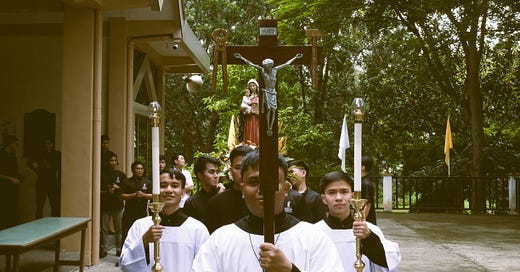Being Pilgrims of Hope from Saint Hannibal Mary's Spiritual Practice
In 1898, Saint Hannibal Mary Di Francia organised one of many spiritual pilgrimages to La Salette, following his return from the actual sanctuary. What made this recreation extraordinary was the participation of Sister Mary of the Cross (Melanie), the original visionary of La Salette herself. The pilgrimage was carefully choreographed with three stations set up in the western direction, complete with a vessel containing water mixed with the authentic La Salette water. The community processed with prayers and songs specially composed for the occasion.
At first, Melanie humbly declined to recount her experience of the apparition, being reluctant to speak about herself. However, upon Saint Hannibal's gentle insistence, she agreed to share her story. The gathered community listened in deep silence as she began with her characteristic soft voice, "I was watching my owner's cows..." and proceeded to narrate the apparition of the Blessed Virgin Mary. Following her account, Melanie distributed the blessed water using a small glass, which Saint Hannibal preserved as a precious memento.
He later reflected that these experiences become "very tender memories" when approached with simple faith in God, love for Jesus and Mary, the practice of virtue, and hope in eternal life. This event demonstrates how sacred moments can be meaningfully recreated through careful preparation, sincere devotion, and community participation, making historical spiritual events personally relevant for all involved.
Saint Hannibal Mary's approach to spiritual pilgrimage offers valuable insights for understanding our role as "pilgrims of hope" during Lent. His innovative practice demonstrates that pilgrimage transcends physical limitations, showing how sacred journeys can be both internal and external. The communal nature of his devotions emphasises that hope flourishes best when shared, while authentic witness and humble participation deepen our spiritual experience. Through his example, we learn that meaningful pilgrimages incorporate intentional preparation, physical symbols of grace (like blessed water), communal prayer, shared reflection, and sacred remembrance.
For our own Lenten journey, this teaches us to create sacred spaces in our daily lives, combine physical and spiritual elements in our devotions, share our faith journey with others, and maintain a spirit of humble expectation. Most importantly, Saint Hannibal Mary's practice reminds us that being pilgrims of hope means actively engaging our faith through concrete practices while trusting in God's transformative presence throughout our journey.
Reference: Tusino, Teodoro (1973). The Father's Soul, Curia Generalizia of the Rogationist Fathers: Rome, p.344.
Fr. Viktor Emmanuel Aurellana is a Filipino Rogationist Religious Priest.





